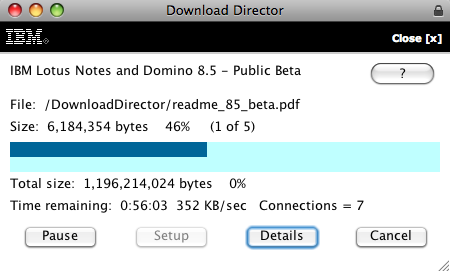Back in May when the first public beta of Notes Domino 8.5 was released I was less than happy with it. Well for the last couple of days I’ve been at the European version of the XPages workshop along with 30 or so other people at IBM Dublin.
The format for the couple of days was to work through creating an example application which uses some of the new XPages functionality. So we’ve just finished and I am sat back in the hotel catching up on emails and missed work, but I wanted to post a few first impressions.
Firstly, the workshop itself was very well organised, I don’t think any of us knew what to expect but when you have the kind of people involved like Maureen Leland, Philippe Riand and Eamon Muldoon it’s going to be interesting whatever happens. The sample application we were developing was very simple in nature but it did lead to some “eureka” moments for me. (It’s important to note that these are my impressions, not official IBM words!)
The decision to not include the LotusScript and Java editors in 8.5 is still a bad one but it’s a lot clearer to me why it was made now. We have just spent two days working on a web app that looks *great* out of the box, and although it would be possible in current versions it would require a lot of coding different design elements to work together. But with an XPage you just have to write Javascript in the XPage design element itself, there is no requirement to write agents. Obviously I have been thinking about XPage enabling IdeaJam and I genuinely think that it can be done using just XPages as opposed to the huge array of forms, pages, views and agents that would be required to get it working currently.
There are still a lot of the benefits of Eclipse that can be made use of that maybe haven’t been pushed as much as they might be…
– The search facility in Eclipse really works well for looking across design elements for instances of code (very similar in functionality to the way I use TeamStudio Configurator), a very useful addition.
– Likewise the compare with feature (although it’s only useful for fully DXL compliant design elements) this could prove to be a great boon for the developer.
– There’s a new “Edit with DXL” menu option which could well increase the use of DXL, which in turn (we can only hope) will improve the round tripping ability of DXL so that in the fullness of time we might be able to think about using SubVersion and other tools which “normal” Eclipse developers take for granted.
We got some great tips about how to develop an XPage, it’s a massive change for the old school Domino developer, but after a while it begins to make sense with some really neat little bits and pieces. For example you can link together client side and server side JavaScript so that simple decision making can be given to the browser while serious business logic remains on the server where it should be. The use of CSS and themes should offer realy flexibility in the look and feel of an app.
Wow that was all a real stream of conciousness posting. As I spend more time on XPages over the next weeks and months I hope to post some useful tips and examples.
If you’re a Domino developer I would definitely recommend downloading the latest beta, it’s a lot more stable and usable than the last one. And get going on learning XPages, they are the way of the future for Domino web development, you need to be learning this stuff. And best of all… it’s actually fun to use 🙂

